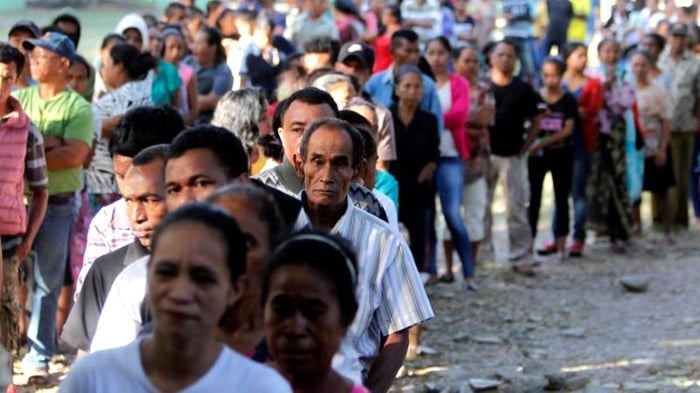 DILI, 16 July 2009 (IRIN) - A decade after voting to end Indonesia's 24-year occupation, Timor-Leste is struggling with one of its thorniest socio-economic problems: half the men aged between 20 and 24 in Dili, the country’s largest city, are unemployed.
DILI, 16 July 2009 (IRIN) - A decade after voting to end Indonesia's 24-year occupation, Timor-Leste is struggling with one of its thorniest socio-economic problems: half the men aged between 20 and 24 in Dili, the country’s largest city, are unemployed.Various government and non-government initiatives are in place to address this problem, but in the absence of foreign investment or a dynamic local private sector, much more is needed, say analysts.
An estimated 20 percent of the country’s 1.1 million inhabitants are unemployed.
About 90 percent of the workforce is employed in agriculture, though this is largely seasonal, subsistence work, leaving an estimated 40 percent of this cohort effectively underemployed.
According to the UN Development Programme, 50 percent of the population lives below the national poverty line of US$0.88 per day, despite oil-based GDP per capita of $4,500 for 2008.
The country ranks 158th out of 179 countries in the UNDP Human Development Index, making it the least developed country in Asia.
“Job creation is vital to economic and political stability. With a median age of 21.8 years, creating jobs for the youth is integral to any employment programme in this country,” Fernando Encarnacao, a youth employment and community empowerment specialist for the International Labour Organization, told IRIN.
Youth violence
“With so many young people idle, it is easy to see how they became involved in 2006,” he said, referring to the social instability that year.
More than 150,000 people were displaced during violence between rival groups within the army and police and among the wider population.
According to the Internal Displacement Monitoring Centre (IDMC) , the crisis was caused by political rivalries dating back to the independence struggle up to 1999, divisions between “easterners” and “westerners”, as well as chronic poverty and a large and disempowered youth population.
James Scambary, author of an April 2009 report, Groups, gangs and armed violence in Timor-Leste, added that political manipulation of dozens of youth gangs contributed to the unrest.
Moreover, these groups, largely comprised of “young kids with nothing else to do”, continue to engage in crime and violence, he said.
But addressing such a problem is not easy. An estimated 15,000 young people enter the job market each year, and with 35 percent of the population younger than 15, the issue will become more pressing in the future, not least if the discrepancy between Timor-Leste's GDP per capita and real living standards is not addressed.
A way forward
One approach adopted by the government is to promote entrepreneurship and self-employment, in tandem with better skills training and business-oriented thinking for school leavers.
“Generating self-employment is vital. People see business opportunities, but cannot access capital. We provide credit to help,” said Angelo Soares of Tuba Rai Metin (Feet Firmly on the Ground), an NGO specialising in microfinance programmes.
However, according to MP Fernanda Borges, who leads the opposition National Unity Party: “Foreign investors are unlikely to come to this country while our skills base remains low.”
Timor ranks 170 out 181 on the World Bank's Doing Business Index, making it a difficult location for start-ups and new enterprises. It also means more reforms are needed to attract foreign investment, though some non-oil sectors are attracting external interest.
“There are parties looking to invest in construction and tourism,” one World Bank official said.
For now, locally generated employment, possibly involving public works programmes, would help to improve the infrastructure and road system, while providing jobs for idle youth.
President Jose Ramos-Horta told IRIN the government would employ "thousands of people" to build 4,000km of new roads.
But according to Brenda Barrett of the Education Development Center in Timor-Leste, “Youth in Timor-Leste need to learn by doing.”
Barrett runs the USAID-funded Preparing Ourselves for Work programme, working alongside local organisations to provide training on and off the job for 16-30 year-olds.
“We aim to generate professionalism, a work ethic, and much-needed self-confidence,” she said.
This accords with Scambary's view that undermining gang culture “needs more than jobs; it means a sense of entitlement, and community responsibility and acceptance”.
But with so many young Timorese out of work, large-scale projects may prove vital in the short term as government agencies and NGOs cannot reach everyone.
“I haven't received any skills training, or been informed about any employment schemes,” said Edio da Silva, from Becora in Dili. He is 19 and has been out of school and out of work since he was 14.
“I just stay home. Many of my friends do the same,” he said.
sr/ds/mw
Theme(s): (IRIN) Economy
[ENDS]
Fonte: http://www.irinnews.org/Report.aspx?ReportId=85299 Photo: Simon Roughneen/IRIN Getting young people back to work is seen as a key challenge for the recently independent nation









Sem comentários:
Enviar um comentário